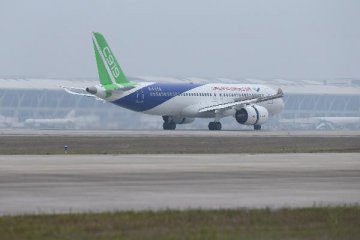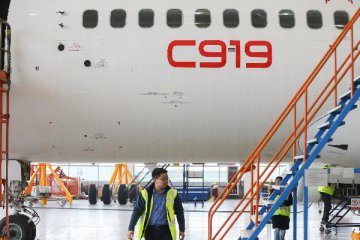
China's first domestically produced passenger jet the C919 is expected to take its maiden flight on May 5, subject to weather conditions, said Commercial Aircraft Corp of China (COMAC).
Prospect: aviation market is expected to reach one trillion yuan
With the introduction of the C919 and relevant industry policies, the aviation industry is expected to embrace huge demands from various fields and levels to exceed a scale of one trillion yuan.
Data shows that as of the end of 2015, the per capita flights in China were 0.32, up 167 percent over the last 10 years. Huo Daren, executive director of Boeing Civil Aircraft Group China, predicted that China’s air transportation market will need another 7,000 aircrafts in next 20 years, and will become the world’s first market that exceeds one trillion US dollars. China Merchant Securities and other securities companies predicted that by 2030, the global market will need about 14,500 new single-aisle passenger jets with 160 seats, and China will need about 2,650 such airplanes. COMAC estimates that at least 2,000 C919 airplanes will be sold. Assuming that each C919 is worth 50 million US dollars, the market will exceed 100 billion US dollars (about 690 billion yuan).
It is learnt that the C919 has secured 570 orders from 23 clients around the globe. In addition, the aero engine market has a promising future. The National Manufacturing Strategy Advisory Committee (NMSAC) predicted in an authoritative report that the global market will have a huge demand for aero engines in the next decade. The total demand for turbofan and turbojet engine around the globe will exceed 73,600 units, valued over 400 billion US dollars. The demand for turboshaft engine will exceed 34,000 units, valued over 19 billion US dollars. The demand for turboprop engine will exceed 16,000 units, valued over 15 billion US dollars. The demand for piston engine will exceed 33,000 units, valued over 3 billion US dollars. Meanwhile, China’s trunk liners will need for over 6,000 units of large engines at a total value of over 50 billion US dollars. As the low-altitude airspace opens, the demand for general aircraft engines will also increase.
NMSAC said that the aero engine special project is an important driver to promote a rapid development of China’s aero engine industry. Based on the Made in China 2025 initiative, the scale of China’s aero engine industry will exceed 70 billion yuan at the end of the 13th Five-Year Plan period. Some China-made products will enter the international market. By 2025, the industry scale will exceed 100 billion yuan. China’s aero market is expected to become one of the world’s largest aero markets.
Securities companies also pointed out in their research reports that the aero engine market sees a huge demand. There are only three companies in the world, including GE, PW and RR, that can independently develop aero engines. As China launched the aero engine special project and AVIC Commercial Aircraft Engine Co., Ltd. was established, China’s aero engine industry will grow rapidly, and is expected to win some international market share in the future.
Tendency: aviation industrial cluster forms rapidly
With the production and delivery of the C919 and the launching of key aero engine models, an aviation industrial cluster will take shape at a faster pace in China. Wu Guanghui, chief designer of C919, told the Economic Information Daily that once the C919 is formally delivered, it will not only bring huge benefits to the aviation industry but also promote the development of the industry. Currently, the production, supporting and assembly of C919 involve hundreds of enterprises in Shanghai, Xi’an, Shenyang and other major cities and their surrounding areas. Its upstream and downstream industrial chains cover fields like aviation manufacturing, new materials, metal processing, avionics equipment and precision instruments. It is an obvious trend for the aviation industry cluster.
COMAC said that C919’s core components are provided by AVIC Shenyang Aircraft Commercial Corporation (SACC), AVIC Xi’an Aircraft Industry (Group) Company, Harbin Hafei Industry Co., Ltd., Sichuan Chengfei Integration Technology Co., Ltd. and AVIC Jiangxi Hongdu Aviation Industry (Group) Company, and it is finally assembled by COMAC.
It is learnt that Shenyang, Xi’an, Chengdu, Harbin and Nanchang where these companies are located have become core cities for the aviation industry. With the production and delivery of the C919, China is expected to form five aviation industrial clusters in the east, northeast, northwest, southwest and middle regions with above-mentioned cities and Shanghai as core.
In fact, based on the 13th Five-year Plan and the implementation plans for the “Made in China 2025” initiative, it can be found that these regions are accelerating the construction of an integrated aviation industrial cluster. Taking the East China as an example, many cities in the Yangtze River Delta, including Shanghai, Zhenjiang, Changzhou and Jiaxing, prepared plans for the development of the aviation industry, designed to support the C919 passenger jet. They have built aviation industrial parks and introduced large numbers of supporting manufacturers.
Zhu Qiangsong, vice director of Zhejiang Development & Reform Commission, told the Economic Information Daily that after China launches large airplane project, Zhejiang has made layout in the aviation industry to support the production of large airplane. It sorted out a list of enterprises that are qualified to become suppliers for the large airplane project, and integrated industries with Shanghai. In 2009, Zhejiang started the construction of aviation & aerospace industrial park, with a total investment of over 10 billion yuan. The industrial park has attracted dozens of enterprises, including HT-HYSA Security Engineering Technology Co., Ltd. which supplies rear fuselage for the C919. Currently, Zhejiang Aviation & Aerospace Industrial Park has become a national-level new industrialized demonstration base for the aviation industry. Dozens of enterprises in the park were selected as suppliers for the C919 which provide about 10 percent of the parts and components of the C919.
Translated by Coral Zhong





















Latest comments